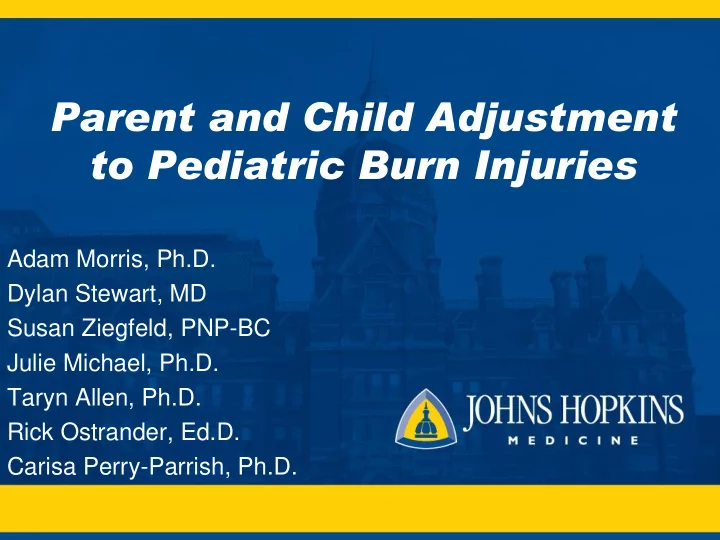

Parent and Child Adjustment to Pediatric Burn Injuries Adam Morris, Ph.D. Dylan Stewart, MD Susan Ziegfeld, PNP-BC Julie Michael, Ph.D. Taryn Allen, Ph.D. Rick Ostrander, Ed.D. Carisa Perry-Parrish, Ph.D.
Disclosures • none
Adjustment and Quality of Life • Quality of life (QOL) – Emotional functioning, pain, daily activities, hobbies/sports, school and social functioning • Burn injuries can lead to poorer QOL outcomes in children, but outcomes vary Landoldt, et al., 2009
WHAT PREDICTS QOL OUTCOMES IN CHILDREN?
Parent outcomes of child burn injuries • Burns in children are among the most stressful medical events for a parent • Parents at risk for developing symptoms of PTSD and depression November 12, 2015 5
Parent Symptoms • Parent PTSD and depressive symptoms – significantly associated and predictive of child PTSD Morris, Gabert-Quillen , Delahanty, 2013 • Same pattern has been found with pediatric burn injuries Hall et al., 2006
DOES THIS APPLY TO CHILD QOL FOLLOWING BURN INJURY?
Current Study • Retrospective chart review – September 2014 to September 2015 • Children and parents routinely seen/screened by a pediatric psychologist as part of multidisciplinary outpatient clinic – Time 1 approx~1 week post-injury – Time 2 approx~1 month later
Measures • Children’s/Infant Dermatology Life Quality Index (CDLQI) – 0-3 infant version & 4-18 child version – Time 1: • M=7.05, moderate impairment • Range: 0-30 – Time 2: • M=5.93, mild-moderate impairment • Range: 0-23 – Higher scores=poorer QOL
Measures • Short PTSD Rating Interview (SPRINT) – Sum score of hyperarousal, avoidance/numbing, and re-experiencing symptoms of PTSD – Time 1: • M=6.94, moderate • Range=0-32 – Time 2: • M=4.76, mild • Range=0-21
Measures • Chosen to capture clinical need • Brief • Well validated • Child measure does not exclusively focused on psychopathology – Most children do not develop PTSD
Participants/Demographics Older QOL, Ages 4-18 Younger QOL, Ages 0-3 • Age • Age – M=8.85, SD= 3.44 – M=1.6, SD= .83 • Gender • Gender – 50.1% Male – 61.1% Male • Race/Ethnicity • Race/Ethnicity – 41% Black – 42% Black – 37.8% White – 32% White
Results Time 1 Initial assessment (~1 week) Older version (n=71) Younger version (n=65) • QOL/Parent Sx • QOL/Parent Sx • r=.41, p <.0001 • r=.50, p <.0001 • Parent sx • Parent sx significantly significantly assoc assoc with child QOL with child QOL scores when scores when controlling for child controlling for child age and gender age and gender β = .30, p < .01 β = .49, p < .01
Results Time 2 follow-up (~1 month) Younger version (n=18) Older version (n=29) • QOL/Parent Sx • QOL/Parent Sx r=.59, p< .001 r=.51, p< .05 • QOL/Parent sx • QOL/Parent sx significantly assoc significantly assoc controlling for child controlling for child age and gender age and gender β = .46, p < .01 β = .43, p =.12
Longitudinal Analyses • Parent sx at T1 significantly predicted poorer QOL at T2, controlling for QOL at T1 • Effect of Time 1 QOL on Time 2 QOL disappears • Older version β =.54, p<.001 • Younger version β =.54, p<.01
Discussion • Parent symptoms predict child QOL impairment • Child QOL AND parent symptoms should be routinely assessed following a burn injury • Screeners are brief, feasible, clinically relevant and appreciated!
Limitations • Limited to outpatient burn population – Possible limited generalizability • Small sample size • Did not include injury characteristics • Unclear how psychological functioning associated with wound care/adherence
Future Directions • Combine with burn registry • Examine mediating and moderating influences • Injury characteristics – TBSA – Burn severity – Location of burn • Time elapsed since injury
Recommend
More recommend